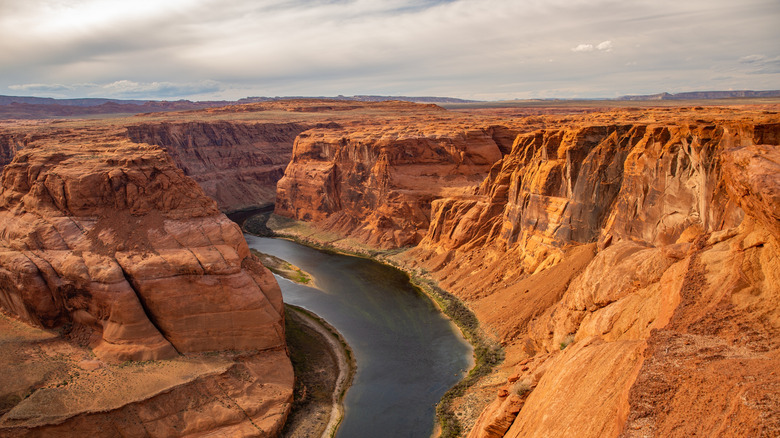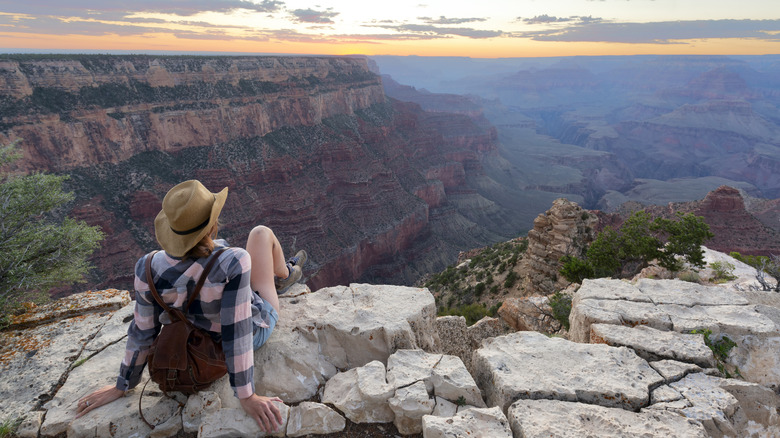Arizona's Picturesque National Park Is A Unique And Ancient Natural Wonder
When it comes to spellbinding natural landscapes, it's hard to beat Arizona. With spots such as the Lost Dutchman State Park, with hiking trails and stunning night skies, to a preserve boasting fossils and colorful desert scenery, this Southwestern state packs a serious punch when it comes to outdoor wonder. While we could list off dozens of attractions worth your time, one destination clearly tops the list: the iconic Grand Canyon.
Established as a national park in 1919, the preserve occupies over 1,200,000 acres of stunning landscape and welcomes nearly 5 million visitors each year. The park protects 278 miles of the Colorado River's snaky flow, with the canyon itself reaching depths of nearly 6,000 feet in places. The average width rim-to-rim is 10 miles across, though in some spots can stretch out to as far as 18 miles. While the gorge is the star of the show, the park also contains buttes, spires, and otherworldly rock formations, as well as over 1,700 varieties of plants, along with a host of wildlife, including some endangered species.
The Grand Canyon and its surroundings — with rocks and structures that date as far back as 1.84 billion years ago – have been home to humans for more than 12,000 years, as evidenced by the 4,300 archeological sites found in the park. That said, Native American culture still thrives there today. The Havasupai tribe maintains a village inside the Grand Canyon that is only accessible by foot, pack mule, or helicopter, while the Navajo, Southern Paiute, and Hualapai have communities along the canyon's rim. This awe-inspiring gorge has long been sacred for Indigenous people, and just one visit will tell you why.
Take in the wonder of the Grand Canyon from the South Rim
Just four hours by car from the Phoenix Sky Harbor International Airport, the Grand Canyon's South Rim is the easiest way to see the park. Once you're there, make sure to check out the Grand Canyon Visitor Center, which offers all the information you need for your trip to the park. The center is also situated right next to Mather Point, which features sweeping vistas of the canyon in all its vivid glory.
One great way to experience the Grand Canyon is by hiking or biking along the Rim Trail. This (mostly) paved 13-mile route is a terrific way to take in the splendors of the canyon for those not keen on overexerting themselves on one of the steeper, more exposed trails. If you are feeling adventurous, lace up your shoes and head into the canyon on the Bright Angel Trail. Just know that it's 15.8 miles out to the Colorado River and back on the canyon floor, so day hikers should only plan on going partway down. Another popular route is the steep — but view-rewarding — South Kaibab Trail, which features some of the South Rim's best lookouts, including the appropriately named Ooh Aah Point. For those looking for a multi-day trek, tackle this less-traveled, beautiful backcountry route.
While most visitors drive to the South Rim, another option is to jump on the Grand Canyon Railway. This tourist train features old-time steam locomotives and ferries visitors between the town of Williams and Grand Canyon Village. A trip on the Grand Canyon Railway is not only a relaxing chance to take in the arresting high desert scenery in comfort, but it also feels like stepping back in time, with live musicians and actors portraying larger-than-life cowboy characters.
Get off the beaten path on the North Rim
If you're looking for true solitude at the Grand Canyon, you may want to consider heading to the more remote North Rim, which is about a five-hour drive from Las Vegas International Airport. This section of the park receives fewer than 1 million visitors a year — just a fraction of what's seen on the South Rim — guaranteeing an experience free of crowds. (Note, however, that's it's only open seasonally and closes each winter.) It's also said to have better sunsets and more colorful scenery than its southern counterpart, which attracts photographers eager to capture the local magic.
Like the South Rim, hiking is the name of the game here, with paths such as (another) Bright Angel Trail, a 0.5-mile stroll to one of the park's most spectacular viewpoints. The 1.9-mile Bridle Path Trail is the only trail that allows bikes and pets, while the North Kaibab Trail descends into the canyon, where it connects with the South Kaibab Trail as a 24-mile rim-to-rim hike. If you'd rather have livestock do the work, you can also experience the Northern Rim on the back of a mule, with several options, including a three-hour jaunt into the canyon. And while you're on the trail, always keep your eyes peeled for wildlife, including mule deer, elk, bison, and bighorn sheep.
Hiking in the Grand Canyon is a serious affair. The heat, aridity, and steep, rugged conditions make it one of the most deadly national parks in the U.S., based on the number of fatalities. Before you set off, make sure you have plenty of water and shade protection, and never try to do too much in one day. For a charming jumping-off point to the North Rim, check out Fredonia, a small town with big appeal.


